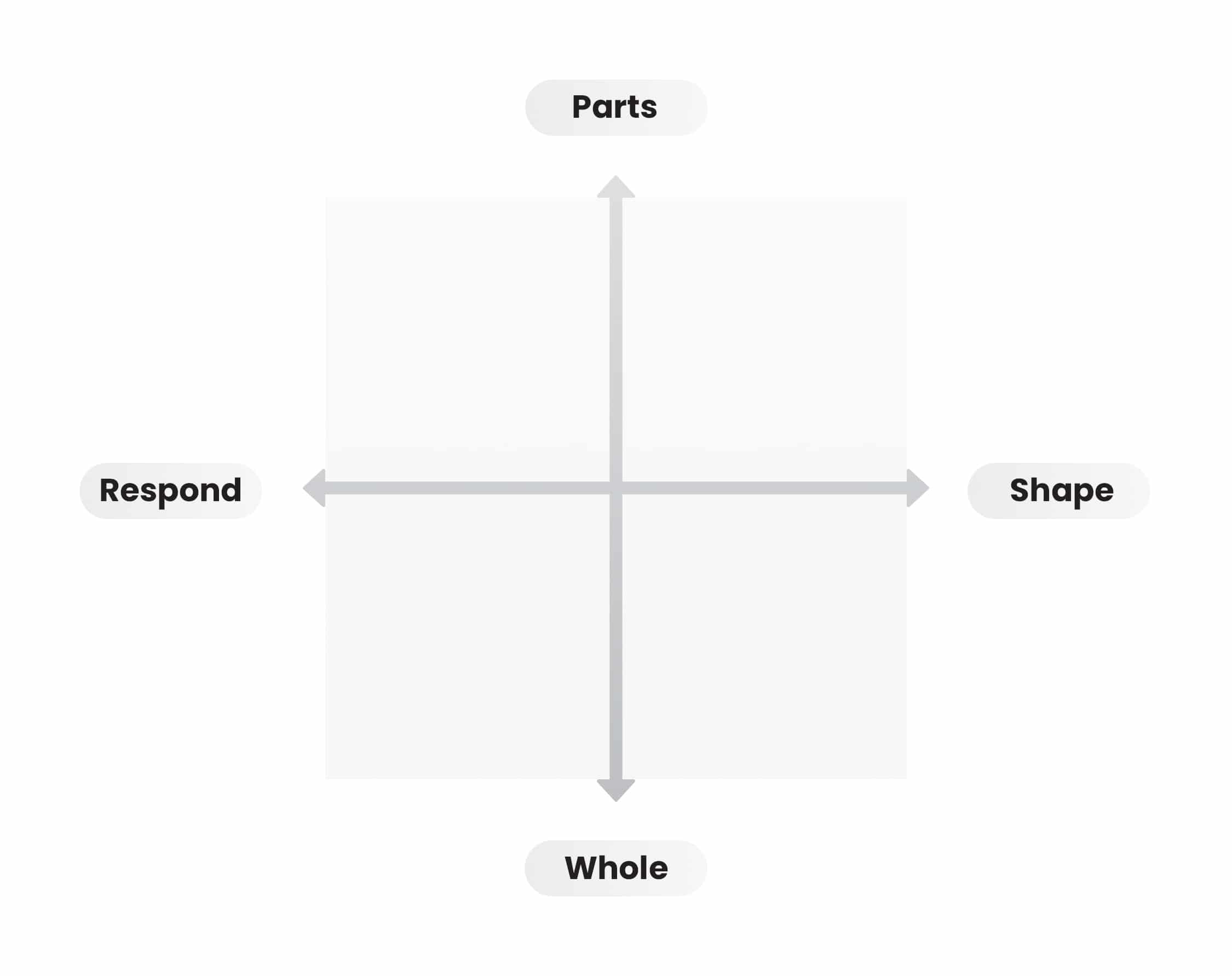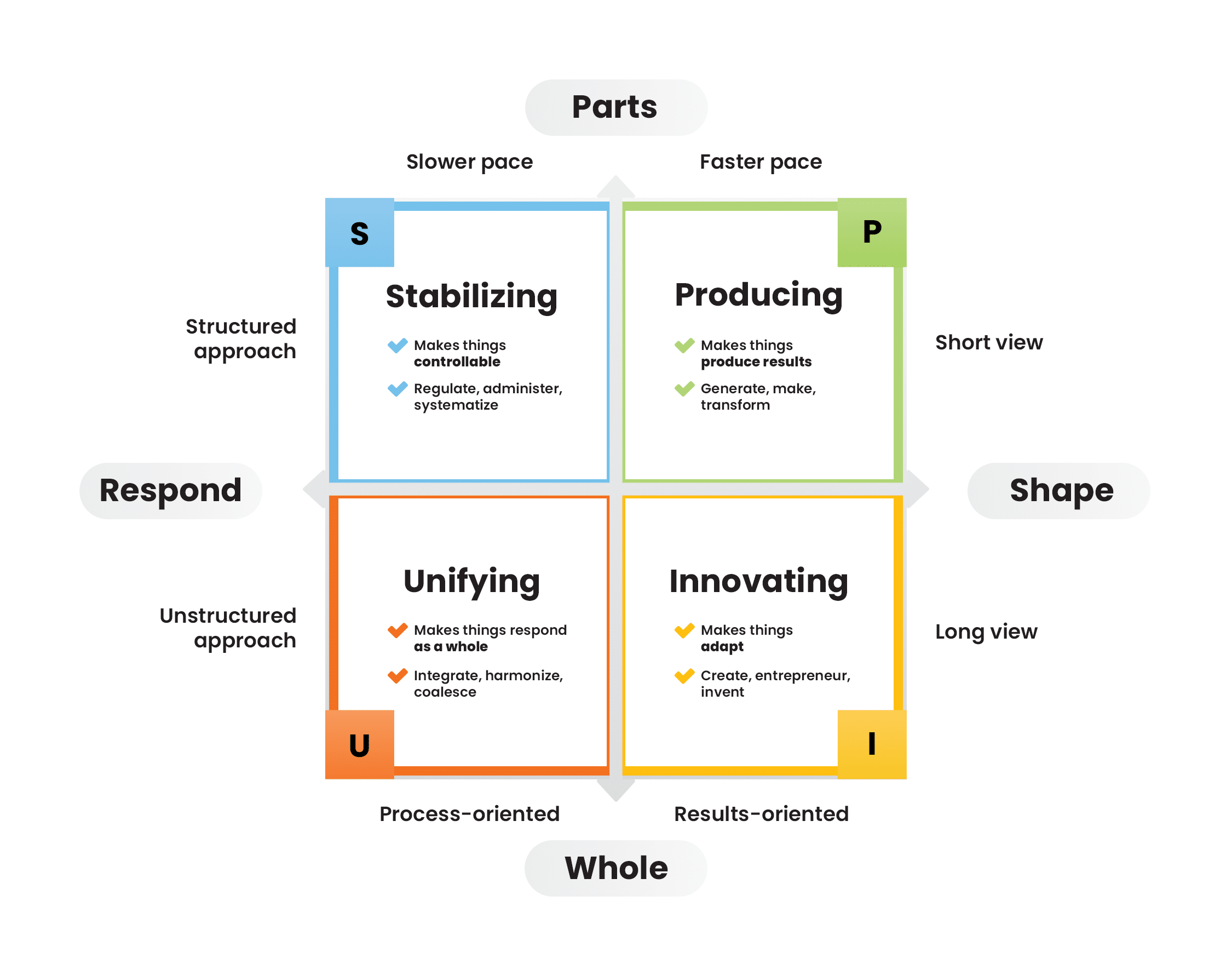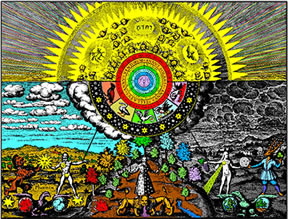What is Force is Needed Now?
Summary Insight:
Management isn’t mystery. It’s physics. Understand the forces behind behavior, and you’ll know exactly how to steer your team, your company, or yourself—at any scale, in any situation.
Key Takeaways:
- All behavior in complex systems boils down to four forces: Producing, Stabilizing, Innovating, and Unifying.
- Each force competes for energy. Misapplied force—or imbalance—creates dysfunction and failure.
- Great managers identify the dominant force at play and adjust accordingly, like a physicist running an ecosystem.
The secret to understanding management is this: Complex adaptive systems (such as people and organizations) must (1) shape and respond to changes in the environment and (2) do so as whole organisms, including their parts and sub-parts. If they are unable to do so, they will cease to get new energy from the environment and will perish.
Intuitively, this makes sense. For example, imagine a family of four. If the family is to survive and flourish, it must shape the environment by getting resources such as money, food, and shelter. It must also respond to the environment, including to changes that are economic, societal, ecological, and so on. At the same time, it must pay attention to the all the parts that make up the family system – things like the act of cooking, cleaning, commuting, paying the bills, and taking the kids to school. It must take into account the different and often conflicting needs of the individual family members. It must also give focus to holistic dynamics so that the family acts like a single, unified whole – for example, making sure that there’s plenty of love, warmth, laughter, support, and nurturing for all of its members.
If the family isn’t able to shape or respond to the environment, or if it loses focus on the parts or the whole, it will quickly run into trouble. If the pattern continues, then the family will disintegrate. Just imagine a family that doesn’t have income, or a family that can’t perform its daily routine, or that can’t respond to new economic changes, or whose members are always fighting among themselves. Obviously, it’s not a family you’d want to be a part of. It is not resilient or adaptive to change. It costs all of its members more energy than they get in return. Such a family is on the precipice of complete failure.
The same is true for every organization. It must be constantly shaping and responding to change while focused on the parts and the whole. Therefore, I am going to classify observable behavior, at its most basic level, as either shaping or responding to change while focusing on the whole organization or on its parts or sub-parts. I call this the Adaptive Systems Model of organizational behavior.

The dimensions of behavior within the Adaptive Systems Model exist on a relative and time-dependent scale. For example, if there’s a high drive to shape the environment, then at the same time, there will be a lower drive to respond to change. If there’s a high drive to focus on the parts, there will be a lower drive to focus on the whole. You can see this in your own life. Notice that, when the daily pressures and actions of work and life consume you, you’re also not simultaneously focused on the big picture. That’s why you periodically “get away from it all,” go on vacation, or take time out to get a new perspective. Notice too that if you’re busy building a new business, you don’t have the time and energy to respond to all the little vicissitudes of life, family, friends, and so on. As the farmer once said, “there’s a season to sow and a season to reap and they don’t happen at the same time.”
All behavior can be viewed and understood through this basic model. Note that I’m not talking about “good” or “bad” behavior, nor about why something is behaving the way it is – only that it is behaving along these relative dimensions. Now that you have an overview of the basic dimensions of behavior, you can use this framework to reveal some amazing insights into the people and situations you’re attempting to manage and to do it more effectively. Here’s how.
The Four Forces of Organizational Physics
Using the Adaptive Systems Model as a guide, we can see that the behavior of any complex adaptive system — an individual, a team, or a company — can be broken down into four basic types or forces. We call these the Producing, Stabilizing, Innovating, and Unifying forces 1. These forces co-exist along a continuum that we can map on two axes, representing the drive to shape or respond to the environment and the drive to focus on the parts or the whole organization.

The Producing force demonstrates a drive to shape the environment and is focused on individual components or aspects of the system. The Producing Force is what makes things produce results. Synonyms are to “generate,” “make,” and “transform.” Within a business, this is the drive to generate tangible results such as making the sale, completing the code, and getting the work done.
The Stabilizing force demonstrates a need to respond to changes in the environment and is focused on individual components of the system. The Stabilizing force is what makes things controllable. Synonyms are to “regulate,” “administer,” and “systematize.” Within a business, this force shows up as the ability to systematize the work being performed, including a drive to create greater efficiencies, improve quality, or reduce liabilities.
The Innovating force demonstrates a drive to shape the environment and is focused on the whole system. The Innovating force is what makes things adapt. Synonyms are to “create,” “entrepreneur,” and “invent.” Within a business, this is the ability to sense and act on new opportunities, to be disruptive of the status quo, and to anticipate and adapt successfully to change. You’ll notice it strongly in entrepreneurial endeavors, new product development, R&D, and strategy.
The Unifying force demonstrates a need to respond to changes in the environment and is focused on the entire system. The Unifying force is what makes things respond as a whole. Synonyms are to “integrate,” “harmonize,” and “coalesce.” Within a business, this force shows up as the need to create teamwork, interpersonal connections, and a sound group culture.
With a little practice, you can begin to see the Producing, Stabilizing, Innovating, and Unifying forces just about everywhere you look. That is, the four forces are scale-independent. You can spot them from the macro to the micro, including within tasks, functions, individual behavioral styles, and your entire organization. Let’s take a look and see how the four forces behave in a similar fashion at all levels of an organization:
At the macro level, the four forces dictate the behavior of how a business performs in the marketplace. A high-tech startup requires a very high Innovating force to disrupt the market and a Producing force to build the product. Compare this to a senior citizens’ home. This needs a very high Stabilizing force to make sure that processes and regimes are followed and a high Unifying force to help the residents feel like they’re part of a community.
And as you dive deeper into how an organization functions, you’ll see the same four forces at work. R&D requires a high Innovating force. Sales needs a high Producing force to win accounts. Accounting needs a high Stabilizing force to limit liabilities and focus on every dollar and penny. The CEO needs to make sure the business is Producing results, Innovating for market demands, and Unifying the team around a consistent vision and values.
Because a company is really just a collection of the people involved, you’ll begin to spot the same four forces within the management styles of those doing the work. For example, a good account manager will express a high Unifying force in order to connect well with clients. A good accountant will have a high Stabilizing force that makes it easy to keep the books in order. A good entrepreneur will have a high Innovating force to spot opportunities, as well as a high Producing force to take action.
Even work tasks themselves can be understood through the four forces. For example, the product development process needs good throughput (Producing force), attention to detail (Stabilizing force) and good teamwork (Unifying force). The strategy process needs good creativity (Innovating force). The controller process needs attention to detail (Stabilizing force).
So the four forces are always at work within an organization. But not all forces are present in equal amounts. Instead, the four forces exist in co-op-etition. They must cooperate because without all four, the organization would quickly cease to exist. But the four forces also compete for available energy. When one force is consuming most of the available energy, that naturally leaves less for the remaining forces. This imbalance of forces is what drives observable behavior. When one force is taken to an extreme, it shows up in a particular pattern. More on this later.
How to Manage it All
With different forces all around, deep inside the organization and far outside in the market and our lives, how can you possibly manage it all? The truth is that you are already attempting to manage it. This is just what is. Managing organizations and people can often seem chaotic, challenging, and frustrating. Disorder or crises can strike at any moment. Especially in fast growing companies, management actually feels like operating in permanent white water. You just do your best to keep your head above water and not sink. Still, what the four forces show us is that there is order in apparent chaos. And when you have a sense of the underlying forces involved in a person, team, task, or situation, you gain a profound awareness and can respond more astutely.
As I mentioned elsewhere, the term “management” means many different things to different people. In fact, there are almost as many different views on management as there are managers! Depending on who you ask, management sometimes means controlling, administering, leading, inspiring, overseeing, and so on. Plus there are the many different styles of management – autocratic, democratic, participative, data-driven, instinct-driven, theory X-Y-Z, visionary, practical, disciplinarian, laissez-faire, etc. This list goes on and on and the answer to “What is management?” is usually dependent on context, including time, culture, situation, and experience. But what is management, really?
The answer is this: management is the application of force.
By “force” I, of course, don’t mean coercion, compulsion, or pressure but rather the application of the Producing, Stabilizing, Innovating, and Unifying forces. In short, to manage it all, you need to understand and use the appropriate force for a given situation. There are many factors that go into the right application of force. These factors encompass both strategy and execution that we’ll investigate more deeply in other sections. However, there’s one general rule of thumb that will help anyone to be a better manager.
The rule of thumb for better management is this: Identify the force behind what you want to manage.
If you understand the makeup of forces behind what you want to manage, then like a talented doctor working at the underlying causes of a disease, you can work at the underlying causes of behavior. Spotting the forces isn’t hard at all. With a little practice, you can begin to quickly break down any behavior into its component forces and become a much better manager as a result.

For example, imagine that you’re a little league baseball coach. It’s the first day of practice. The kids show up and they’re eager to play. How do you get the best out of the team and create a positive experience for everyone involved, including yourself? According to this model, the first thing you do is to identify the forces behind what you want to manage. Here’s how it works.
Begin with you. What type of baseball coach are you? Are you a strong Producer who leads by example and exhorts the team to play harder? Are you a strong Stabilizer who excels at planning a well-run practice schedule by the numbers? Are you a strong Innovator who finds creative ways to manage the game, train the players, and create breakthroughs? Or are you a strong Unifier who excels at creating a strong team spirit and all-for-one-one-for-all mentality?
Of course you have all of these dimensions to your personality but, if you look closely, you’ll see you’re exceptional at certain things and, when you’re engaged with them, you experience greater energy, joy, and satisfaction. Other tasks cost you more energy than you experience in return. Perhaps you love to speak in front of the team and share the innovative strategy to win each game but the act of putting together a daily practice schedule is not your strong suit. In this case, it indicates that you’re a stronger Innovator and weaker Stabilizer and so you’ll want an assistant coach who can complement you where you’re weaker and he or she is stronger. Remember that it takes a complementary team to win the pennant.
As you and the assistant coaches execute your season, you’ll need to make sure that there’s the right balance of forces working within the team throughout. The ultimate goal of the team is to get more runs than the opposition and win enough games to win the pennant (Producing force). In order to do that, you’ll need to ensure that the players understand the rules of the game and each knows the basics of their stance, swing, position, and situational awareness (Stabilizing force). You’ll also want to engage in activities that build team unity and ensure that the boys are playing well together (Unifying force). As the team progresses in the basics, you’ll need to add new training techniques, more advanced and creative playmaking, and new strategies based on the increasing skills and awareness of the team (Innovating force). All four forces are necessary to win the pennant.
When you break things down into forces, it becomes faster and easier to see what the team really needs and give it to them. Let’s say that the team is winning games. This could mean that the Producing force is really high and the team is performing at a high level. But it could also mean that the competition is lousy and your team has gotten lucky. Which is it? Perhaps you notice that the team is getting cocky and there’s fighting among some of the players. Over time, this could negatively impact the team’s ability to win games. In this case, you’ll want to up the Unifying force by finding ways to create a team-first mentality. Or let’s say that the team isn’t winning games, the practice schedule is a mess, there’s no organization or discipline, and things are rapidly falling apart. In this case, you’ll want to reassert the Stabilizing force to bring some order and discipline to the situation. Once that’s in place, you can look for quick victories to rebuild the Producing force by focusing on hits, outs, solid playmaking and wins. If it’s a long season and the players are losing their enthusiasm, you’ll need to amp up the Innovating force to keep things interesting and cutting-edge for the players.
Throughout the season, you’ll want to assess the forces behind the individual players and coaches too. What are they dealing with and where do they need training and support? For example, little Bobby has high energy, can’t sit still, and swings wildly at each pitch. You recognize that you’ll have to give him some extra attention to focus on the task at hand (Producing) and to develop a strong stance and technique (Stabilizing). If he can develop those forces, he’ll be a good player and so you resolve to coach him in those areas. On the other hand, little Fernando has got a natural swing. He is focused and loves to win (Producer), is a natural leader, and makes everybody on the team a better player (Unifier). In order to coach Fernando, you know that you’ve got to build a trusting personal bond with him first because Unifiers tend to need that deep interpersonal connection in order to trust and thrive. If you can establish that trusting bond with him, Fernando can help you build a strong sense of team and enjoy a great season.
Depending on which forces are balanced or imbalanced, you will need to adjust your coaching style and the focus of each practice. If you amp up the wrong force, or in the wrong sequence, you’ll have a big mess on your hands just as if you allow the necessary and needed force to diminish. For example, if the team is winning games and playing well, the Producing force is doing just fine. But what force should you give the team next? It depends. You won’t want to amp up the Producing force so high that the team burns out. Nor will you want to amp up the Stabilizing force so high that things get too rigid and no one is having fun. Nor can you go crazy on the Innovating force by constantly throwing new information and strategies at the team without their first having integrated past lessons. They’ll just feel confused and their faith in you as a manager will falter. But you also can’t allow the Unifying force to get so extreme that politicking, infighting, and back-stabbing take over. The team needs to be unified to such an extent that it helps them be resilient but not so inwardly focused that they lose sight of winning the game.
There’s a time and a place for everything and understanding what force to apply as well as how much, when, in what sequence, comes from knowledge and experience. In other sections, I discuss how to execute on any given strategy by understanding where the organization is in its lifecycle and then giving the organization the forces it needs to progress to the next stage.
For now, it’s enough to keep this in mind: The art and science of management is recognizing the forces at work within a system and adjusting them along the way. This is true with both a little league team and a Fortune 500 company. Ineffective management is just the opposite. It occurs when the wrong force, the wrong amount of force, the wrong sequence, or the wrong timing are applied. When this happens repeatedly and systemically, an organization will fail. And notice that there are many more ways for things to go wrong than right! (Yes, entropy is always at work).
The terms “right” and “wrong” are not value judgments but physics statements. If you step hard on an upturned rake in the grass, the handle will hit you in the face. It’s not right or wrong to step on a rake but the result is predictable. If you keep stepping on the rake, you’ll keep getting hit in the face. Effective managers will work with – not against – the laws of physics. This means, first of all, understanding the forces and patterns in front of you. Then you can look at any aspect of your organization — from the actions of individuals to the company’s performance in the marketplace — and understand how it got to be that way, anticipate its future behavior, and steer that very behavior towards greater integration and success.
This is the real art and science of management. Simple, right?




